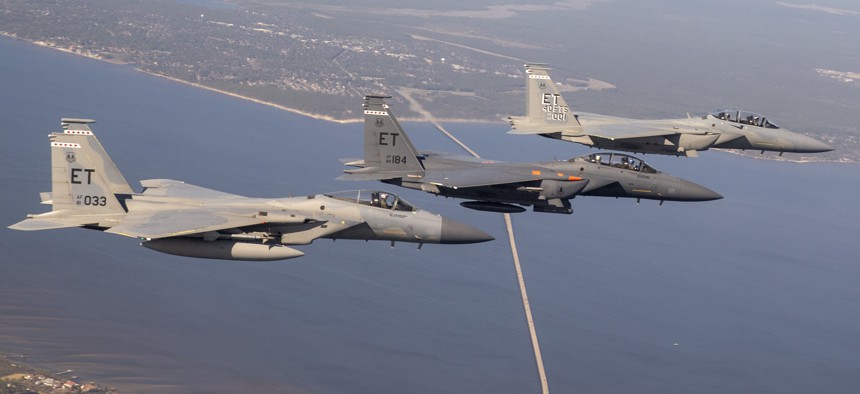
An F-15C, F-15E, and F-15EX fly together over Florida in March 2021. Tech. Sgt. John Raven/USAF
Boeing’s Fighter Jet Business Is Not Dead Yet, New Defense Boss Says
“We’re investing,” says Ted Colbert, outlining company plans on the eve of Farnborough Air Show.
Boeing is making investments to build new combat fighters, even though it hasn’t designed a front-line warplane in more than three decades, the company’s new defense boss said.
Ted Colbert, who became CEO of Boeing Defense, Space & Security in April, spoke as the U.S. Air Force holds a secret competition for a next-generation fighter jet.
“I can't speak to the specific…projects. I can just tell you that we're investing,” Colbert said during a Sunday briefing in London on the eve of the Farnborough Air Show.
Asked whether Boeing should be included in discussions about the classified Next Generation Air Dominance project, he said, “I'd ask the government about that.”
Air Force leaders have declined to say much about the contest since it was unveiled in September 2020, and have not named the companies competing to win, leading to speculation and analysis of ambiguous statements made by defense executives on quarterly earnings calls.
Lockheed Martin is the only U.S. maker of fifth-generation fighter jets and Northrop Grumman is the lone maker of long-range stealth bombers. Boeing still builds new versions of F-15 and F/A-18 fighter jets for the U.S. and its allies, but has not created a new fighter-jet line since the 1990s. It built key parts of the F-22 fighter for Lockheed, but that plane has been out of production for more than a decade. In 2001, the Pentagon chose Lockheed’s F-35 over Boeing’s X-32 as its future combat fighter back.
Still, in 2018 the Air Force chose a new, Boeing-designed pilot training jet over existing planes built by Lockheed and Italian defense firm Leonardo.
“Fighters [are] important business to the Boeing Company,” Colbert said. “We have a Phantom Works organization that has, does today, and will continue to invest in the future of fighters— that's facilities, that's people, that's technology.” Phantom Works is Boeing’s advanced development group that operates largely in secret and is responsible for designing and developing new aircraft and technology.
Beyond combat fighters, Colbert discussed how he intends to run Boeing’s $26 billion defense and space business differently than predecessors. He signaled the company would not take as much risk when bidding for Pentagon contracts, a practice that has cost the company billions of dollars as it has struggled to deliver new aerial refueling tankers, two new Air Force One aircraft, pilot training jets, security helicopters, and a Navy refueling drone.
“We'll take the approach that makes the most sense,” Colbert said of future bids.
Boeing CEO Dave Calhoun has criticized the company’s low-ball bids for fixed-price contracts, which require the company to pay for any development hiccups.
“The priority right now is delivering the commitments and the programs that we have today,” Colbert said. With the exception of the two new aircraft being modified for use as Air Force One to fly the U.S. president, Colbert said, “every single one of those programs, we believe, have tremendous opportunities in the future.”
The company has “learned a ton of lessons” from its shortcomings on several defense projects, he said.
Colbert several times touted the company's efforts to develop technology that will allow future aircraft to fly autonomously. He also said there is “a lot of interest in other parts of the world” for the E-7 Wedgetail, a radar plane flown by several American allies and is now being purchased by the U.S. Air Force to replace old AWACS planes. “Dynamic threats around the world” are driving interest in the E-7 and the P-8, a submarine hunting plane flown by the U.S. Navy and allies.
Don't miss:




